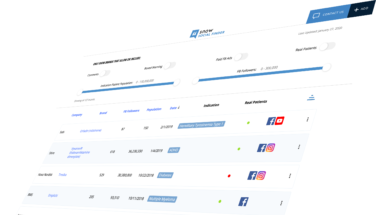With over 15 years of experience in health and wellness marketing and media, Bill Veltre has held key roles at Elsevier, WPP (CMI), Publicis Health Media, and AbbVie, and has led media planning, buying, and executional strategies for clients including GSK, AstraZeneca, Johnson & Johnson, Incyte, and Sanofi. Now at BMS, he leads omnichannel strategy. Many in the industry have struggled to get omnichannel right, and Bill is passionate about this topic. PM360 reached out to get his insights on how the industry can improve its omnichannel approach and realize its full potential for marketers.
PM360: What is your assessment of where the industry currently stands with omnichannel?
Bill Veltre: Pharma is in a constant omnichannel evolution that has been going on for many years with no definitive end in sight due to how fast data and tech change around us. Our industry is over 300 years old, and while we may be able to bring medicine to market faster, we unfortunately have not spent as much time updating our data infrastructures with the same speed. So, most marketers are in the same spot, trying to launch strategic campaigns across stakeholders aimed at putting their product in the hands of viable patients all while collecting as much data as compliantly possible. Then, attempting to collate signals where the data connections exist and auto optimize to create a subpar version of “omnichannel.” For all “other” disconnected data, we manually analyze and subjectively optimize. In short, the plumbing is not all connected and there are many leaks! So we are all seeking skilled plumbers—help wanted!
Why is pharma still behind other industries, despite this being such a prominent buzzword for years?
First and foremost is the abundance of data that pharma companies have and the infrastructure they utilize in order to organize the data is often overwhelmed. The plumbing again is not built for change or self-filtering and may lack connections, which causes leaks. In many cases, the use of data lakes turns into overcrowded data warehouses, where data is stored and never used to produce a closed-loop data ecosystem. As a result, analytics teams retroactively and manually look at data for trend breaks to produce observations that lack true insights to drive impactful optimization in real time. This disconnected loop is more reflective of “mono-channel” or “multichannel” of decades past.
Second, with the abundance of data the timing of inputs can sometimes be misaligned to potential optimizations. As a result, the ability to further engage a stakeholder is missed, because data collection is not properly aligned with the most appropriate next best action or engagement. This requires time-shifted proxies and data read out strategies to extract the right insights.
The last barrier is a people issue: unrealistic expectations setting. Data timing, optimization execution, and signals all require time. In some cases, storytelling is the only way to link one insight to another to showcase impact. In the midst of good storytelling is expectation setting with leadership. Good marketers are transparent with leadership, tell them what is possible and what isn’t. But some marketers leave out that results take time, and as a result leadership expects a “hockey stick” trend line with immediate improvements days following the launch of media or optimizations. Marketers are the key storytellers who need to frame projected results in a way that pulls through the “omnichannel” approach without having all the data in hand. It takes keen marketers with premonition-like instincts.
What is the most important thing the industry can do to help overcome those barriers?
Pharma must invest in new ways of working to solve people, process, or priority obstacles. Centered on flexibility and agility, taking action to improve people barriers starts with soft and hard skills analysis—putting the right trained talent in seats to appropriately drive an omnichannel approach. Additionally, marketers who are in control of forecast and budget should be extensively trained in promotional strategies, media, and measurement. This will make the pull-through strategy and objectives to storytelling more comprehensive, realistic, and impactful. Processes should also be overhauled to make old data new again and to find ways to minimize data latency or “warehousing.” Ultimately, you need to create a closed-loop marketing ecosystem that has no definitive end. Finally, set priorities and stick to them. A moving goal post is a kicker’s foe.
What are some omnichannel wins you have seen that demonstrate that good omnichannel marketing is possible for pharma?
I am seeing some inspiring building blocks in the marketplace to make omnichannel a reality. There has been an uptick in deeper partnerships between agencies, clients, and media partners in the industry to drive more impactful strategies that provide data infrastructures and valuable data sharing. Another win is the appreciation for omnichannel throughout the pharma organization, from leadership to sales teams. Everyone is talking about omnichannel. In years past, there was fear of digital and other touchpoints, but cross-functional teams are embracing the need for complementary marketing efforts to drive effective impact.
Lastly, I’ve seen and heard about the building of marketing engines that support next best action and more. Many of these platforms are utilizing artificial intelligence (AI) and machine learning (ML) to model and predict behaviors, while also streamlining execution to drive engagement and results. The most exciting part of these engines is the possibility to streamline process and cut time. Changes that used to take months, can easily be implemented in days or weeks. This is a game changer for pharma.
How can pharma better prepare for the evolution of omnichannel tactics as marketing technology advances, especially in terms of AI?
Take your time, and make sure you are nailing the basics. Foundational media strategies are still the cornerstone of omnichannel and will be the base for future promotion. AI is not the answer; it is a tool in the toolbox, and still needs to be executed with the proper strategies, setup, and maintenance. It is critical we embrace new technology and find the right business cases to test and learn. AI is not 100% fool proof, it requires experimentation and the ability to fail to learn, just like the teams that support these efforts.
Finally, remember that teams of people are critical to run AI. At its core, the technology doesn’t learn without human insight and institution. We would all like to push a button and have a Jeston-like work experience, but advanced marketing technology still needs highly skilled teams to drive the results an organization expects. While all this tech is exciting and omnichannel sounds great, know that our latent need to help patients doesn’t change, it only gets stronger!
The opinions in the article are his own. They have not been approved or endorsed by his employer and do not necessarily represent his employer’s positions or opinions.







